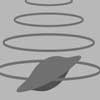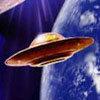Space Travel – Flying Saucers & Anti-Gravity
 by John W. Dean
by John W. Dean
The question is often asked: “When did man first imagine space travel?” First, we must realize that he thought of the air as extending all of the way up to the stars, so it would be some method of flying, as a bird flies. Early attempts were based on crude types of flapping wings.
“We find the dream of space travel in the earliest legends of many races. The Greek and Norse gods lived in the heavens and traveled back and forth with little or no effort. The American Indians thought the Milky Way was a stairway between Earth and sky. And 5000 years ago the Hindus imagined a spacecraft called a garuda for their gods. But space travel for men seemed to be too good to be true.
“In the deserts of ancient Mesopotamia, however, there were serious star-gazers, and to them the heavens seemed more real. There may have been legends of actual space visitors still extant, for the first stories of man as a space traveler came from this region. They were written by Lucian of Samasota before the year 100 A.D. In one story, a ship is blown to the moon in a stormy wind; in another tale a man flies to the moon on giant wings.
“For the next 1500 years (until 1600) man found the notion of space travel too fantastic for his misconception of the world and its surroundings. Mankind and his dreams were stuck here on solid ground because he thought the world was the center of the universe and the heavens revolved around it. Then Galileo with his telescope proved that our world is only a small item in the heavens.
“This was a shattering blow to man’s pride, but he was gradually reconciled by dreams of visiting other worlds. Established religion took its stand against that being possible, so he could only dream of it, and fanciful stories of space travel began again. As time went on they became more realistic as he became more serious about it.
“Cyrano de Bergerac wrote of spacecraft powered by rockets in 1648. Edgar Allen Poe wrote of a trip to the moon in a balloon; Jules Verne wrote of a missile-craft shot from a great cannon. By 1880, man’s space-traveling imagination had stretched beyond the moon. An Englishman wrote of a trip to Mars in a space ship powered by a force called negative gravity. All these tales, along with the ancient legends, are a part of man’s early dream of space travel, but it was a reality and had been going on for many centuries between more advanced planets.”
Much of the foregoing is borrowed from a Q and A column in the Houston Chronicle of Feb. 5, 1962, and I felt that it was very appropriate as an introduction to my early experiences.
On the last day of December 1899, our family moved from Carthage, Missouri to a farm near Helena, a crossroads village in Oklahoma Territory. During the summer, a traveling salesman came along with his horse and buggy with a load of large books titled The Story of a Hundred Years and we bought one. I was in the fourth grade in the country school with little reading matter at home, but I avidly studied that book and its illustrations, especially the last picture in it. It was an artist’s conception of a flying ship—actually a boat about twenty-five feet long with a cabin and a steam engine inside, for it had a smokestack projecting upward. At the rear was a propeller like a small windmill wheel. On each side was a small wind; with such a load, about as effective as a penguin’s flippers. A rudder and a man at the steering wheel made it look very convincing. On the deck there strolled two or three fashionably dressed ladies with their long veils floating backward to show that they were moving forward at least 20 miles an hour! Opinions expressed were about equally divided as to whether or not men would ever fly in the air; those in opposition were the loudest. Of course, a ship built like that one would not fly, and it was some time before the Wright Brothers built one light enough to fly as high as that one appeared to be.
In Carthage, I presume that I heard of horseless carriages. I do not recall ever seeing any on Garrison Avenue, but no one doubted the possibility of a single-cylinder self-propelled buggy. I think the first one I saw was in Nickerson, built like a spring-wagon with high “carriage” wheels and a steering lever. The larger wheels were better on the rough dirt roads and especially for deeply-rutted country lanes.
I think I was yet in the fourth grade in Carthage when my older brother came home one afternoon and said that, at the little corner grocery store across the street, they had a machine that could talk! I can still remember the surge of unbelief that swelled in my little Missouri heart, but he was older and bigger, so I argued only with myself. We had a Singer sewing machine, but it did not sing! Out on the farm, we had a mowing machine and, when heard from a half mile away, it sometimes sounded like people chattering.
It was well that I kept my own counsel for, that evening, we all went over to the grocer’s home and heard an Edison phonograph talk and sing. It was the original model with an almost upright horn that traveled along a threaded bar. Of course there was a needle of some kind, but I saw only the wax cylinder with lines around it, which I was not allowed to touch. It was wound up with a crank and released; as it began to buzz it announced the name of the song and also announced itself as “Edison record”.
Before we left Carthage, there were telephones in public places and in business offices. My brother, in Central school, predicted that in years to come, one could go outdoors and talk to a man a hundred miles away without wires! Gas lights gave way to electric-arc street lights at the intersections and I accepted the new innovations as a matter of course. Horse cars were replaced with electric trolleys, and an interurban line ran to Joplin. My brother had salvaged some worn out wet cell batteries and kept them in the wagon shed as curiosities, for our father had been warned that they would “draw lightning”.
Of course balloons had been in use for decades, mostly for exhibition purposes at county fairs; seldom as a means of transportation, for they traveled only with the wind. Pictures showed them with a small engine and a pulling propeller which eventually led to dirigibles.
I think all pictures of space ships with wings or propellers are fakes. Remember, our air fades out to nothing about 100 miles up. It has a pressure of 14.69 pounds per square inch at sea level, but only about half that at an altitude of 3.5 miles. So jet propulsion for planes is used at great heights and for greater speeds.
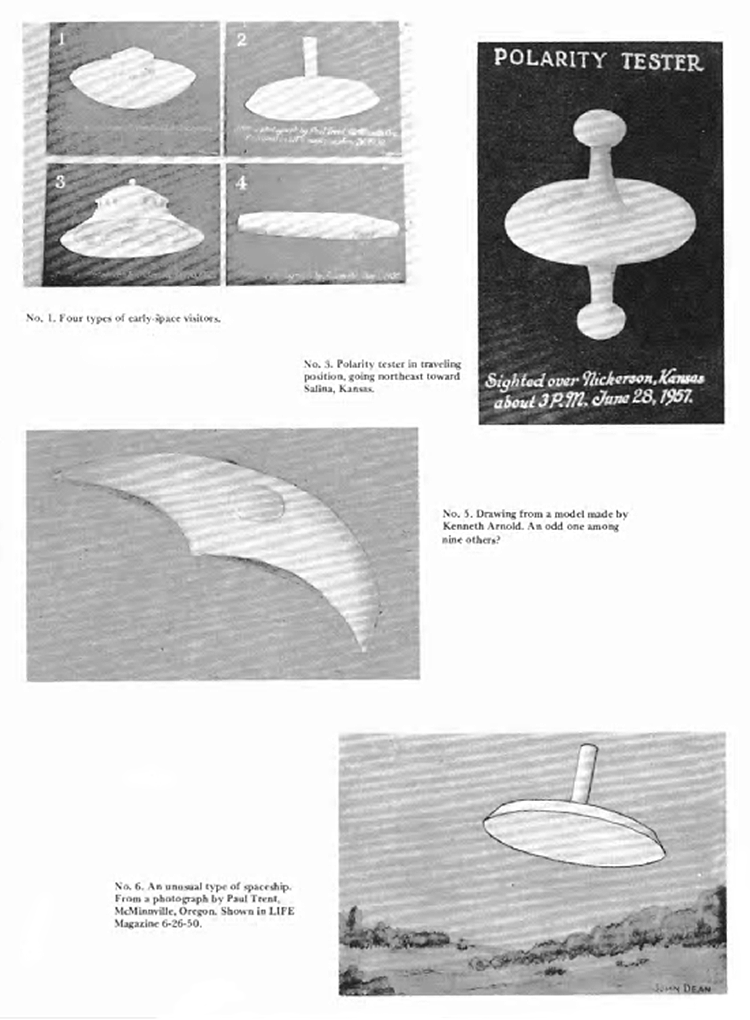 The special floating car belonging to Orii-Val of Korender (Fig. 9-see below), and probably kept at the Massachusetts base, might be considered as a space ship that uses fuel and jets, but rises by antigravity instead of air pressure under the wings. It may be a standard type, but specially instrumented for Earth use, teleported all the way here from Korender, 411 light years away. And this, too, in my lifetime!
The special floating car belonging to Orii-Val of Korender (Fig. 9-see below), and probably kept at the Massachusetts base, might be considered as a space ship that uses fuel and jets, but rises by antigravity instead of air pressure under the wings. It may be a standard type, but specially instrumented for Earth use, teleported all the way here from Korender, 411 light years away. And this, too, in my lifetime!
Its speed would be reduced by the atmospheric drag to about 14,800 miles per hour in the upper air, but could reach 203,000 mph up where the pressure was one pound per square inch. Orii-Val (the owner) preferred it at 1000 mph at a convenient altitude where he could watch terrain.
Now, a little insight into the differences in the two kinds of ships, and also how the space folk would aid us in overcoming the defects and deficiencies in our planes. Must of this was given in Part 28, in Issue No. 22 of the UFO-I Magazine March-April 1965. The speaker is Anta-Verron (new RK-11 scientist) in reply to a letter of inquiry from editor Gabriel Green regarding the increase in major air disasters plaguing our airlines, military forces, and private planes.
“I want to begin with a discussion of the basic inefficiencies common to all of your aircraft. They require brute force to operate. Whether they are propeller-driven or jets, the engines provide all of the power for propulsion and for maintaining altitude. Rather than working with gravity, your craft fight it from the time they take off until their landing. Lift is dependent on velocity, in any case. Below a certain speed, the pressure on the lower surface of the wings is not sufficient to maintain it in suspension, and the craft loses altitude.
“Poor maintenance causes many crashes. We suggest that better maintenance of aircraft engines would eliminate many crashes, especially of private planes. They should be checked and tested at least once a week. Plumbing and wiring should be kept in A-1 condition; wire and hose connections checked and tightened after every flight.
“For commercial planes, engines should be dissembled periodically and all of the bearings and shafts checked for wear, cracks, burns, and other factors that come from usage. Lubrication equipment should be kept in top condition. Fuel pumps and lines should be checked for breaks, leaks, and wear. All too often time is short and checking is omitted just once too often.
“Landing gear should be given the greatest care and often needs to be stronger for added safety. Plug-in electric modules should be replaceable in flight. This is where most failures take place, for the electrical equipment is the “brain” of the craft.
“All aircraft should have automatic landing devices and they should be such that the pilot may override them.
“Most mysterious crashes are due to magnetic interference—outside interference with controls or instruments; magnetic flux of sufficient intensity to jam equipment; a magnetic vortex which literally destroys the ship. Our space ships, especially, the round ones, are designed to distribute this vortex flux evenly throughout the craft, and allow no build-up of the great field strengths. Also, our ships generate strong fields of their own, giving us further protection by negating most of the effects of the vortex. We know where the vortices are, but their position vary too much to be charted.
“We would suggest that you shield your instruments in soft iron cases to eliminate as much magnetic interference as possible. Or use more non-magnetic materials in control parts.”
PROPULSION
From the earliest days of saucer reports people have demanded, “What makes them go?” It would be interesting, now, if we had made a list of all of the nonsensical methods suggested as—they are living creatures, so are self-propelled. They are operated by wishful thinking; the crew or passengers sit around a table, holding hands, and think the ship into motion, turns, or sudden stops as directed by the captain. One, around for quite a while, shot a miraculous force ahead which dissolved the air in front and the ship moved into the vacuum due to the pressure on the rear. There may have been some truth in the theory, for it was admittedly dangerous to anyone in its range. It was accepted by people who did not know that space was not full of air. Such ships would have been “air ships”, operable only in the lower air, if at all.
I am quite sure that Frank Scully’s report of a cup-in-a-saucer type of ship, and it was acceptable to him, but he mentioned that there were four little boxes at the “four corners” (90 degrees apart) in the empty space at the rim of the ship that “made it go”. There was no mention of any magnetic pole running from top to bottom of the ship as was shown in the scout ship by Adamski, though both were undoubtedly from Venus.
On page 10 of Issue No. 21 of UFO-I, Renaud and his friends discuss the method of levitation and propulsion of the personal aircraft of Orii-Val (Figure 9-see below). I will condense the conversation as it applied only to that type of craft:
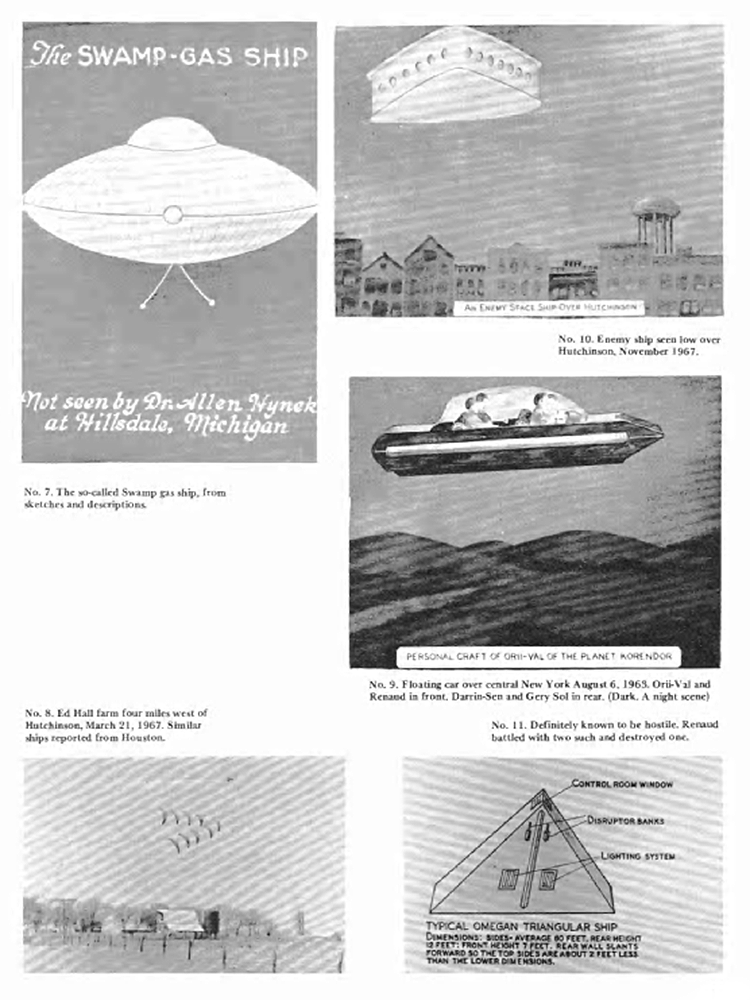 “The properties of levitation (i.e. rising) are achieved by nullification of gravitational flux (flow) by the means of shielding. The outer surface of this craft is made of our alloy, Neutra-F. It was created especially for spacecraft construction. Under ordinary conditions this alloy, which resembles aluminum in finish and mass, is no different from any other material. However, when a radio-frequency field of a certain frequency is applied to it, it becomes an effective shield against gravitic, magnetic, and electrical fields. Under this condition, there is no attractive force between the ship and the planet. So the ship rises because of centrifugal force and atmospheric buoyancy. The former is due to the Earth’s rotation, but it floats on the air like a balloon. A computer adjusts the percentage of shielding necessary to keep it at a steady height.
“The properties of levitation (i.e. rising) are achieved by nullification of gravitational flux (flow) by the means of shielding. The outer surface of this craft is made of our alloy, Neutra-F. It was created especially for spacecraft construction. Under ordinary conditions this alloy, which resembles aluminum in finish and mass, is no different from any other material. However, when a radio-frequency field of a certain frequency is applied to it, it becomes an effective shield against gravitic, magnetic, and electrical fields. Under this condition, there is no attractive force between the ship and the planet. So the ship rises because of centrifugal force and atmospheric buoyancy. The former is due to the Earth’s rotation, but it floats on the air like a balloon. A computer adjusts the percentage of shielding necessary to keep it at a steady height.
“This type of craft is not ordinarily suitable for deep space travel. Its maximum altitude in your atmosphere is ten miles; in Korender’s air it would be fifteen miles.
“As to propulsion—we use jets. Not the noisy, smelly, inefficient monsters that propel your jet planes; ours are almost 100% efficient. Since I had this particular craft especially equipped, I can flash right out into deep space when necessary or desirable, for it is hermetically sealed, reinforced, and supplied with oxygen.
“For steering, we use gimbal-mounted deflectors to send the jet stream off course, thrust being applied to the deflectors and torque being delivered thereby to the ship to turn it. The jets are almost silent, due to the cooling of the air-jet stream mixture which is made in the last stage of the jets. To stop the craft quickly, we cut the power and use retro-jets.”
As to power for the instrument lights, etc. Orii-Val said: “In the rear are two fuel cells, each of which provides five kilowatts of power. That is enough for this craft. They weigh fifty pounds; their output is a continuous 150 volts and they do not drop voltage when the load is increased. Such craft, manufactured on Earth, would cost about $25,000 if you had the technology to build it. The fuel is about 10 cents per pound.”
It had three types of automatic control. The third was a full tape control. “To make a tape—switch on a recorder, the beacon receivers and the sensors. Flying the course once, manually, will make a tape which will thereafter run the same course, including takeoff and landing, and is accurate to within one foot for retracing flight patterns.”
Renaud’s story of the ride in the floating car, page 11, Issue No. 21 tells how they landed in central New York state and got out for a few minutes. Then Bob was told to take the pilot’s seat and take them back to the starting place in the woods. He eased the elevation control forward and rose to 100 feet in a half minute; then another 1900 feet in fifteen seconds; then rotated the ship 180 degrees, and eased the drive stick forward to 500 miles an hour—it was much easier than learning to drive a ground car.
My diagrammatic drawing (Figure 12) began with the sketch on the cover of issue No. 21. I sketched the four men inside and sent it to Renaud for approval. He showed it to Orii-Val who corrected the simple compass curve of the canopy to a graceful camber, as shown, and also indicated the names of the details which are given above the drawing, for neither of us would have known them. From the text, I was able to name fourteen of the thirty instruments listed. The space folk liked it and appreciated my interest in the “car” so I proceeded to redraw it with the men inside and added to it the appropriate scenery and produced a large picture of the ship, low over central New York (Figure 9). Small photographs of that made very realistic pictures which were appreciated, for it was impossible for Renaud to get a photograph of it at the time, or later, in the base.
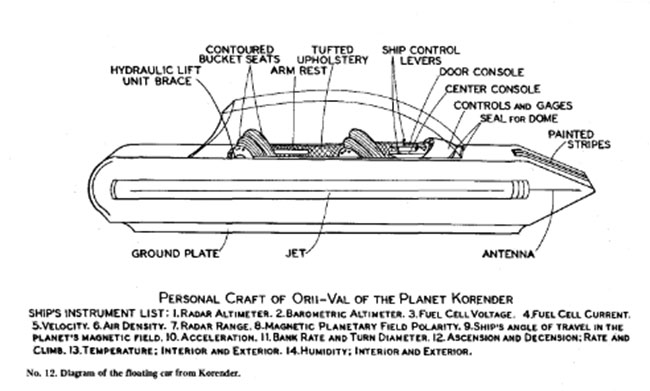 SPACE SHIPS – Korendian
SPACE SHIPS – Korendian
We have almost nothing of the details of ships powered by the magnetic lines of force commonly used by planets other than the Alliance, i.e. Confederation or Neutral. Renaud said, simply: “Concerning magnetic propulsion—as you know, the planet Earth is surrounded by magnetic flux. It flows from south to north, since in reality the geographical south pole is magnetic north, as opposed to something called the north magnetic pole, located near the northernmost point of the American mainland. Now, it moves about so much that is is useless to try to chart it permanently.
“When entering this field, automatic detectors determine the flux intensity and the direction of flow in relation to the ship. There are also many more factors which are too involved for this type of discussion. With the propulsion techniques we use, namely gravitic and magnetic, propulsion is provided from fields generated by equipment inside the craft.
“On Korendian ships, there are two sets of magnetic poles. One is vertical through the center of the ship. The other set of poles is one of two rotating rings on the bottom of the ship. The vertical set of poles repels the Earth’s field with sufficient force to cancel it in the air. For descending, we simply weaken it; to ascend, we strengthen it.
“The poles on one of the rings are used to travel in directions other than directly perpendicular to the field. These are automatically aligned by the computer so that the ring north faces terra-magnetic south and vice versa. The poles are generating independently, and are variable independently or simultaneously, either in terms of strengthening one and weakening the other. The second one of the two rotating rings contains a revolving field, generated by a heavy current whipping around in coils in this ring. The field can be reversed instantly simply by changing the polarity of the current.
“About gravity propulsion we will say, only, at this time, that it relates to resonance with atomic vibration. Perhaps this will inspire you to build such a ship.”
There are three paragraphs under the heading: “Spaceship Drive Also Propels the Occupants”. I will quote only one: “The interior of the ship is shielded by gravity screens which are an integral part of the ship, and affect everything in it. Thus, when the ship accelerates, the entire area inside the grids accelerates with it simultaneously, as if the power were applied to every atom in the ship, individually. This is not a negator of inertia.”
As to scout ships crashing, such as two reported in Nevada (unknown to me): “They are not on record anywhere in the Federation (nor Alliance) so may have been from a non-Federation world, of which there are many. Only seven are known to have crashed on Earth since the year 1800.”
Other gems of wisdom along these lines are scattered throughout the magazines and in Renaud’s personal letters to me. The foregoing will certainly prove to any doubter that we do know something about the subject, and the Korendians, at least, are willing to share it with us.
I will give a little more proof from a letter of July 18, 1967, shortly before Bob’s second trip to the moon, regarding some of the ship floor plans: “XR-K3 is a one-of-a-kind scout ship—not officially a mother ship; made for long trips, and capable of deep space flight. Six smaller manned scout ships are class Gamma-1, and the unmanned units are classes E-1 and E-2. As to the other ship—this is a form F, class B-3 ship, which gives you the outline of the data sheets on the various ships. This is the standard layout for that type of ship, and that particular class. The small scouts in this one are class Gamma 2s. The empty space between the walls and the outer edge of the saucer are just empty, with perhaps a few cables there.
“All doors are the type which slide into the wall when approached. They have no such thing as light bulbs. Either the entire ceiling glows, or small gas tubes provide concentrated light.
“The air-locks used for ingress or egress—are sealed off tight, when in flight. All air circulation and purification is self-contained from an under-floor air-conditioning complex. The temperature is automatically controlled to 72 degrees, and the humidity is kept at a very comfortable 50%.
“As for washing or shower baths, the smaller one is not equipped with showers or tubs because it isn’t meant for such long flights as would require them. The kitchen area section has a basin with water and soap, as well as an ultrasonic washer which eliminates need for both. Just thrust your hands inside and they are clean in ten seconds. On the larger crafts, there are both showers and ultrasonic cabinets to cleanse the entire body fully in thirty seconds. These are contained in the lavatories. The person’s clothing may be worn in the ‘sound baths’ and are cleaned right on the person as he is being treated (cleaned). The ultrasonics literally do away with water and soap, by disintegrating it into the filters which remove the micro-fine dust.
“The ships lose a smattering of air at each opening; very little indeed. The scout air-lock is fully evacuated before the outer door is opened. The personnel lock is never used in space except in emergencies where one must go outside for repairs”. The foregoing was by Arta-Dorrec in a letter direct to me July 28, 1967 while he was replacing Renaud at home and on his job in the city. “As for electric bath and laundry combinations, there are times when no amount of inaudible sound can replace the glorious old luxury of leisurely languishing in a tub of hot water, or feeling the invigorating spray of the shower.” This was while Bob was on his second trip to the moon.
Room for a silly story to illustrate some common misconceptions for outer space? “An Earthman had built a space ship and declared he would fly it to the sun. His friends warned him that it would be so hot up there that it would melt.”
“No. I have planned for that. I will travel only at night!”
To be continued…
Excerpt from Flying Saucers Close Up
Posted in Life On Other Worlds, Other Topics, UFOswith comments disabled.


